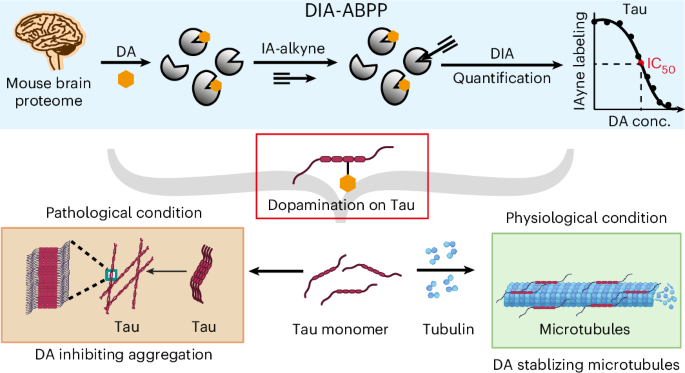2025-03-19 北京大学(PKU)
<関連情報>
- https://newsen.pku.edu.cn/news_events/news/research/14783.html
- https://www.nature.com/articles/s41589-025-01849-9
定量的ケモプロテオミクスによるドーパミンのタウ保護作用の解明 Quantitative chemoproteomics reveals dopamine’s protective modification of Tau
Qianwen Wang,Zhengtao Liu,Youjia Wang,Yuan Liu,Ying Chen,Shengnan Zhang,Wen Zeng,Dan Li,Fan Yang,Zhuohao He,Weidi Xiao,Cong Liu & Chu Wang
Nature Chemical Biology Published:20 February 2025
DOI:https://doi.org/10.1038/s41589-025-01849-9

Abstract
Dopamine (DA) is one of the most important neurotransmitters. Its oxidation leads to electrophilic quinone, which covalently modifies nucleophilic residues in proteins, resulting in ‘dopamination’. Individual dopaminated proteins have been studied, most of which were functionally damaged by dopamination. Here, we developed a quantitative chemoproteomic strategy to site-specifically measure proteins’ dopamination. More than 6,000 dopamination sites were quantified. Half-maximal inhibitory concentration values for 63 hypersensitive sites were measured. Among them, hypersensitive dopamination of two cysteines in microtubule-associated protein Tau was biochemically validated and functionally characterized to prevent Tau’s amyloid fibrillation and promote Tau-mediated assembly of microtubules. In addition, endogenous dopamination of Tau in mouse brain was detected through targeted mass spectrometry analysis. Our study not only provides a global portrait of dopamination but also discovers a protective role of DA in regulating the function of Tau, which will enhance our understanding of the physiological and pathological functions of DA in human brain.


